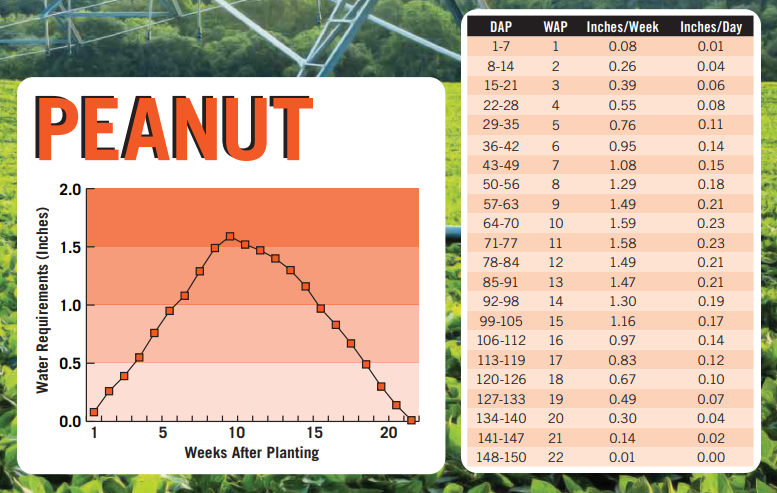
By Jason Mallard UGA Extension Water Agent, David Hall, UGA Extension Water Educator, Phillip Edwards, UGA Water Agent, Wesley Porter, UGA Extension Precision Ag and Irrigation Specialist, and Ross Greene, UGA Extension ANR Agent, Candler and Evans Counties, University of Georgia Cooperative Extension
As we move into the heart of summer, most of Georgia’s peanut crop is now pegging and beginning to set pods, which marks the beginning of peak water use. After a relatively wet spring, conditions turned hot and dry in mid-June. Although some areas have received scattered showers, it is not advisable to rely on rainfall alone to meet crop water requirements.
Manage Peak Water Demands Carefully
July is typically hot across Georgia, and peanuts require consistent moisture during this period to develop properly. Water demand increases significantly during blooming and pegging, averaging approximately 0.2 inches per day for about 20 days. By mid-July, peanuts planted in early to mid-May can require up to 0.3 inches per day, especially on days that are hot, windy, and have low humidity.
Peanuts generally reach peak water usage around 55 days after planting and continue to require high levels of water until approximately 95 to 100 days after planting. After this point, crop water demand begins to gradually decrease. This sustained window of high water use is critical to proper pod fill and overall yield potential.
Example: Peanuts planted on May 10 are 66 days old as of July 15. According to the UGA peanut irrigation checkbook (shown above), this places them squarely in the middle of peak water demand, with water usage exceeding 1.5 inches per week or roughly 0.21 to 0.23 inches per day.
Getting behind on irrigation during this critical period can lead to irreversible yield loss. In the sandy loam soils common across much of Georgia, total available plant water is limited. Even with a rooting depth of two feet, only about one inch of water is usable by the plant. At a daily usage rate of 0.3 inches, this water supply can be depleted in as little as three days.
Tools and Resources to Assist with Irrigation Scheduling
The University of Georgia Extension Checkbook Method is a reliable guide for irrigation scheduling. This method combines average historical evapotranspiration (ET) rates with crop coefficients to estimate weekly crop water needs. While this approach provides a strong foundation, soil moisture sensors and irrigation scheduling apps offer greater precision and flexibility.
The UGA Weather Network is also a valuable tool. By selecting a nearby station and using the Water Balance tab, producers can estimate daily water loss through evapotranspiration. It is important to note that ET is not equal to crop water use. To estimate actual crop water needs, the ET value must be multiplied by the current crop coefficient. Recent ET values near Tifton have ranged between 0.20 and 0.25 inches per day.
Computer-based models such as Irrigator Pro provide additional decision-making support. These systems utilize real-time soil temperature and moisture data to recommend irrigation timing. Irrigator Pro will also notify producers when soil temperatures reach thresholds that may warrant irrigation for cooling purposes, even if soil moisture is adequate.
Ensure Proper Sensor Placement for Accurate Readings
Producers using soil moisture sensors should confirm that their sensors remain in appropriate and productive areas of the field. Gaps in the crop stand caused by disease, emergence issues, or washouts can result in sensors being surrounded by bare ground, leading to false or misleading data. A lack of root activity near the sensor may cause it to record moisture levels that do not reflect actual crop conditions.
Incorrect sensor placement can also affect soil temperature readings in systems such as Irrigator Pro. In areas without a crop canopy, elevated soil temperatures may prompt unnecessary irrigation recommendations. If conditions have changed since the sensors were originally installed, it may be necessary to move them into areas with healthy plants and an established canopy. This will help ensure accurate and representative data throughout the season.
Conclusion
The month of July is a critical window for peanut irrigation, as it overlaps with the crop’s peak water usage. Falling behind on irrigation during this stage can limit pod development and reduce yield potential. Producers are encouraged to use all available tools and data sources to guide irrigation decisions and to routinely verify sensor placement and crop conditions.
For more information on peanut irrigation or to receive help with irrigation scheduling, contact your local University of Georgia Extension office. Additional crop water usage guidelines are available in the following publication:
Irrigation Reference Guide for Corn, Cotton, Peanuts, and Soybeans
UGA Extension Publication C1189